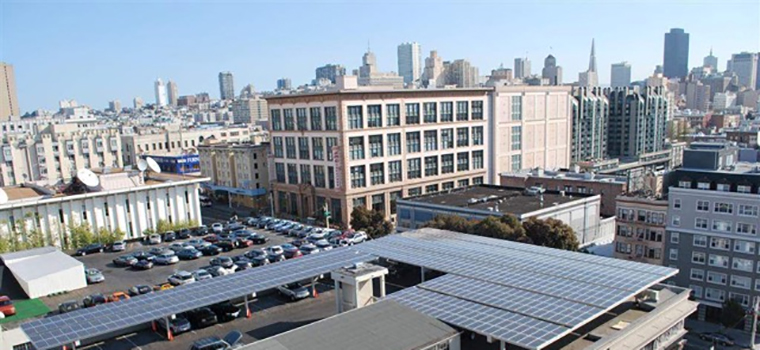San Francisco is stepping up its efforts to reduce greenhouse gas emissions amid reports the incoming administration is trying to derail the nation's environmental protection movement.

When fully implemented, the new law, which requires new buildings ten stories or fewer to install rooftop solar panels, is expected to result in a 30 percent increase in San Francisco’s overall solar capacity. Photo courtesy of Luminalt
By Bill Picture
Published: February, 2017
San Francisco is stepping up its efforts to reduce greenhouse gas emissions amid reports the incoming administration is trying to derail the nation’s environmental protection movement. Eco advocates worry a purported White House-issued gag order preventing any outreach to the media and general public by the federal agencies entrusted with guarding the country’s natural resources is the Trump White House’s first stab at a larger brainwashing effort.
White House press secretary Sean Spicer has vehemently denied the existence of any such gag order, which was first reported by the Associated Press. “That’s nothing that’s coming from the White House,” he said. “They haven’t been directed by us to do anything.”
Just weeks before Donald Trump’s inauguration, aggressive new laws went into effect in San Francisco requiring solar panels be installed on many new buildings, and forcibly upping developers’ game when it comes to meeting already rigorous Leadership in Energy & Environmental Design (LEED) standards.
Solar to the max
An existing state law requires that whenever a new building ten floors tall or shorter is built, 15 percent of the aggregate rooftop is to be set aside for solar energy. But the law falls short of actually requiring the installation of solar panels; and as a result, a fair amount of the allocated space never lives up to its intended solar potential. It’s important to note, however, that rooftop solar is already an unofficial standard to which many developers (and property owners), particularly in San Francisco, already subscribe.
San Francisco’s new “Better Roofs” ordinance, which was approved during the 2016 legislative session and signed into law by Mayor Ed Lee, takes the state law one step further and requires the installation of solar panels. If for some reason solar panels prove not to be feasible, the space must be used for a living/green roof.
“Since the space is already set aside and solar panels are more economical to install during new construction, it makes sense to ensure the owner and the planet benefit as soon as possible,” said S.F. Department of the Environment’s Policy & Communications Director Guillermo Rodriguez.
Roughly 280 new buildings go up each year, based on an average of the last two years. More than 200 of those are all-residential and the majority of those are 10 floors or less—meaning that many structures will be subject to the new law.
To date, 6,600 solar systems have been installed citywide, many of those as part of larger retrofit projects. When fully implemented, the new law is expected to result in a 30 percent increase in San Francisco’s overall solar capacity.
That’s enough clean energy to power thousands of homes, and puts the city a giant step closer to reaching its goal of moving to 100 percent renewable energy by 2030. 40 percent of the electricity delivered to San Francisco (by PG&E) is already generated from renewable sources. One hundred percent of the SF Public Utility Commission’s (SFPUC) power is defined as renewable.
SF Environment reports there’s been no significant objections to the new solar requirement from developers. Stakeholders had the opportunity to weigh in as the ordinance was taking shape, and the changes they requested were incorporated into the final ordinance presented to the Board of Supervisors last year for approval.
As green as green can be
More than 100 million square feet of space have earned LEED certification to date in San Francisco. The requirements for certification range from the use of green building materials, to the installation of energy-efficient lighting systems and water-conserving toilets and fixtures, to the implementation of recycling programs, with different levels of certification awarded to buildings depending on the degree of participation.
State building codes are updated every three years. Standards for LEED qualification are also updated periodically, largely to reflect advances in technology. San Francisco has updated its building codes to reflect both sets of changes, which is a big deal because 50 percent of San Francisco’s greenhouse gas emissions are attributable to the “built environment.” That includes energy use and other environmental impacts related to building construction and operation.
While LEED certification is an option for builders in other municipalities, in San Francisco, LEED standards are the city-required standard for new buildings. “And those requirements have applied pretty much across the board to new development in San Francisco since 2008,” said Rodriguez.
It’s important to note that the recent updates to the local Green Building Code come on the heels of San Francisco being named the top market for green building in 2016 by CBRE Group, Inc.
Rodriguez believes changes like these help attract both residents and businesses to San Francisco. “And sustainability helps San Francisco employers attract and retain a talented workforce,” he added.
Rodriguez points to enrollment in the SFPUC’s Clean Power program and “significant” usage of GoSolarSF, which provides subsidies for solar installation, as further evidence of the green spending inclinations of people leasing and buying property in San Francisco.
“San Francisco is sending a strong environmental message,” said S.F. Department of the Environment Director Debbie Raphael. “Public policies are a reflection of our values, and these new laws make clear that San Francisco is willing to take bold and swift action to achieve results that will make a difference for our communities and our planet.”

More than 200 of the 280 new buildings that go up each year in San Francisco are subject to the new law. San Francisco Department of Environment

